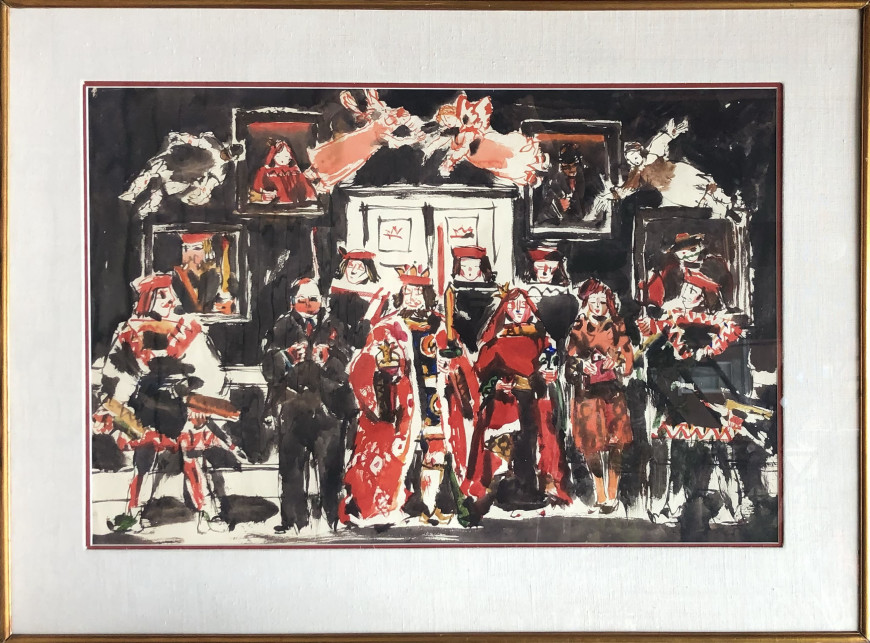-
Artworks
David MilneKing, Queen, and Jokers VI: It's a Democratic Age (Uxbridge, Ontario), 1943-1944 (circa)1881-1953Watercolour on paper22 x 30 1/2 in
55.9 x 77.5 cm
This work is included in the David B. Milne Catalogue Raisonne of the Paintings compiled by David Milne Jr. and David P. Silcox, Vol. 2, no. 404.94.SoldInscriptions
inscribed by Duncan, ‘King and Queen / & Jokers / 3 // W-397A / 1943-1944’ (verso); inscribed by Duncan estate, ‘515’ (verso)Provenance
Godard Lefort, Montreal, 1971.
Marlborough Godard Gallery, 1974.
Private Collection, Montreal.
Exhibitions
Montreal, Godard Lefort, 1971, no. 27.Literature
Duncan Catalogue W-397A.
Milne, 'Snow in Bethlehem' and 'Playing Cards' essay, [c. 1944] (quoted in 403.73), MFP.
Milne, 1962, pg 14-15.
Images for a Canadian Heritage, nd [197-?], 517, repr p 11, as King, Queen and Jokers.
Galerie Godard Lefort, 1971, 27, as King, Queen and Jokers II, 20" x 29 1/2".
Marlborough Godard, Toronto, David Milne: The Toronto Year 1939-1940. Introduction by David Milne Jr. Exhibition catalogue, Toronto: Marlborough Godard Gallery 1976, cat. no. 41, p.12, repr. p. 37.
O'Brian, 'David Milne and the Modernist Tradition,' 1980, p 119; Mira Godard Gallery, Toronto, 1996, p 40.
David Milne Jr. and David P. Silcox, David B. Milne: Catalogue Raisonné of the Paintings Volume 2: 1929 -1953, (Toronto: University of Toronto Press, 1998), no. 404.94, reproduced p. 841.
Publications
This work is included in the David B. Milne Catalogue Raisonne of the Paintings compiled by David Milne Jr. and David P. Silcox, Vol. 2, no. 404.94.David Milne is rightly remembered first and foremost a landscape painter, one with an unmistakable, sophisticated, and highly nuanced approach to nature. That said, he painted figures frequently, whether portraits of his partners Patsy Milne and Kathleen Pavey, or in imagined groups, as in this instance. King, Queen, and Jokers VI, as the Roman numerals suggest, is part of a series in which fantasy figuration eclipses the naturalistic rendering of individuals. Milne was inspired by the book Playing Cards: History of the Pack and Explanations of Its Many Secrets by W. Gurney Benham (1931), which included simple but copious illustrations. The royalty depicted here and across the series comport themselves grandly in front of a portrait gallery of ancestors and worthies. Milne arranges his fancy-dress figures as if in a play, always with one contemporary player on stage in modern dress in the role of the ‘joker.’ We can only speculate on the import of Milne’s unusual subtitle, “it’s a democratic age.” It could be a straightforward reference to the Ontario election held on August 4, 1943, but what seems like a tongue-in-cheek and characteristically playful aside might also refer to the anachronism of placing this modern figure into a play of history. Or perhaps it is the grandeur (or pomposity) of royalty that is out of place during World War II. However lighthearted this image is, Milne, a monarchist, was not mocking royalty. Whimsical too but also significant are the triumphant angels across the top of the image. They lend both an air of the unreal and suggest that this is a Christian court. Milne was a practicing Christian and often depicted subjects related to his faith at this time, including Snow in Bethlehem – a watercolour from 1941– and many versions of Noah. Milne held definite views on both religion and the monarchy, but he was never didactic.
Milne thrived in New York City as a young artist and lived in a large city again, Toronto, in the late 1930s. He was well aware that sales could depend on the connections made in metropolitan centres. Yet he was more comfortable in small towns and remote locals in nature. In 1940, he and Kathleen Pavey moved to Uxbridge, Ontario, just north of Toronto, where they rented a house and nearby studio. This arrangement suited Milne well on two counts: he could travel easily to Toronto on the train, as Parliament Buildings at Queen's Park, 1940, below, shows, and he found much to paint in and around Uxbridge, including the next picture.
Mark A. Cheetham













